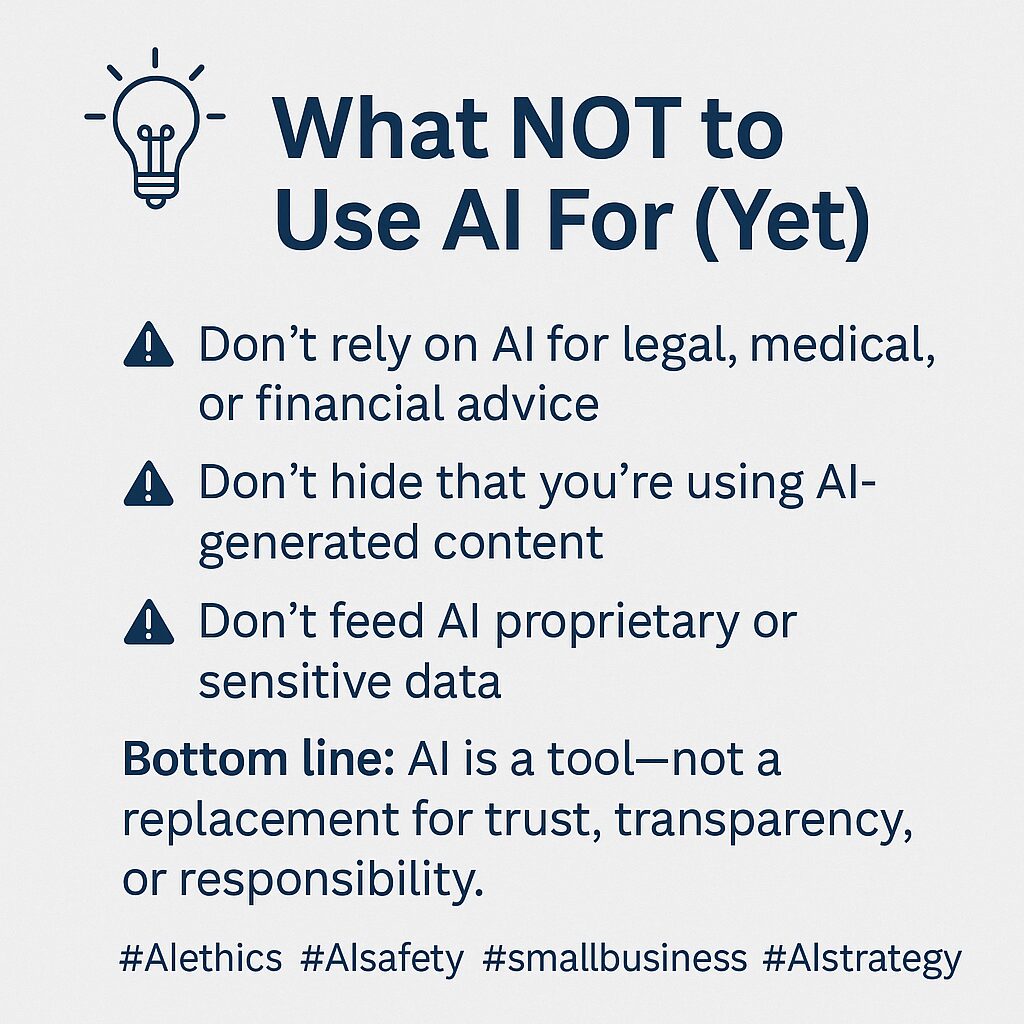How to Create Meeting Notes and Action Items with AI - Post 33
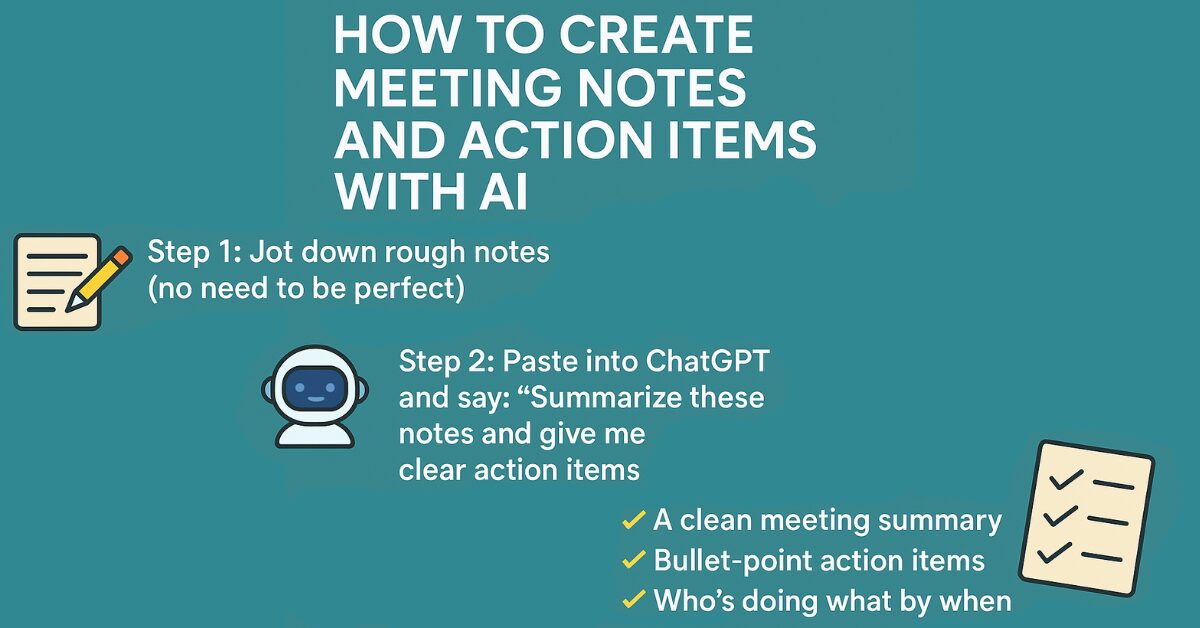
Ever had a meeting that felt productive… but two days later, nobody remembered who was supposed to do what?
Yeah—same.
Let’s fix that. AI tools like ChatGPT can take your messy meeting notes and turn them into clear, structured summaries with action items. Whether you're solo or managing a team, this is a game-changer for staying on track.
Step 1: Record or Take Quick Notes (No Pressure to Be Perfect)
You don’t need to write down everything. Just capture the basics:
Who was there
Main discussion points
Decisions made
Any “Let’s follow up on…” moments
You can use a notepad, a shared doc, or even record the meeting (Zoom, Google Meet, or your phone recorder).
Step 2: Paste It into ChatGPT and Say This...
Open ChatGPT and type:
“Please summarize these meeting notes and list the key action items with responsible people and due dates if mentioned.”
Then paste your notes. That’s it.
Example Input:
Meeting Notes: Discussed June marketing campaign. Sam to design flyer. Jamie to run Instagram ads. Need final approval from Karen by Friday.
ChatGPT Output:
Summary: The team discussed the June marketing campaign strategy.
Action Items:
Sam: Design flyer (Due: TBD)
Jamie: Launch Instagram ads (Due: TBD)
Karen: Approve final campaign assets (Due: Friday)
Now your meeting is clear, follow-ups are obvious, and nothing falls through the cracks.
Bonus Tip: Auto-Format for Email
Just ask:
“Can you format this as a professional follow-up email I can send to the team?”
Done.
Tools You Can Use (Free + Easy)
ChatGPT (Free version)
Google Docs or Notion for storing notes
Otter.ai or Zoom transcription if you prefer audio-based capture
Why This Helps Small Business Owners
You don't need a project manager or fancy software to stay organized. This is like having a virtual assistant who keeps your team (or your solo brain!) in sync without hours of admin work.
Try It Out
Next time you finish a meeting, take 2 minutes to drop your notes into ChatGPT. You’ll be amazed at how much clearer your next steps become.
Want help setting this up for your business?
Houston-based businesses can get a free AI session
Call (832) 975-1825 to Book your free session today!
Or www.dstechsolutions.com/contact
How to Use AI for Better Hiring (Job Descriptions & Screening Questions) - Post 32
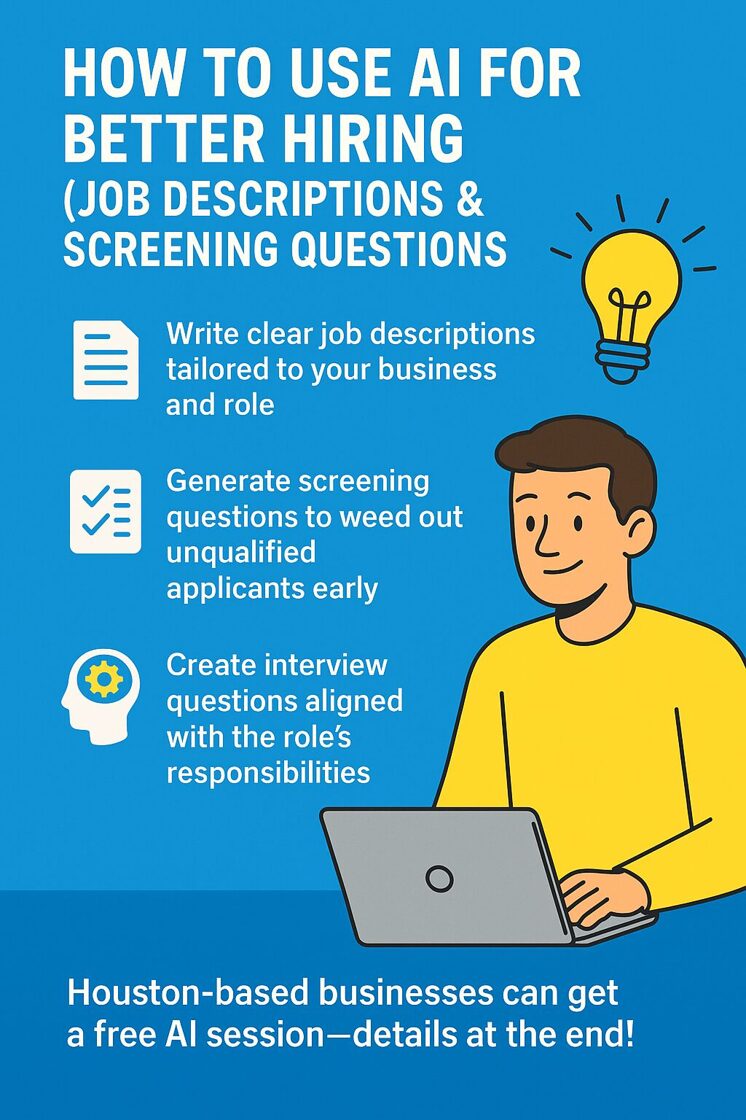
In just one hour, you can use AI tools to:
- Write a tailored job description
- Create screening questions to filter candidates
- Generate interview questions that fit the role
- Summarize and evaluate resumes quickly
Tools to Try:
- ChatGPT – for generating descriptions, questions, and summaries
- Google Forms or Typeform – to collect responses
- Trello or Notion – to track applicants with AI-generated summaries
Try this AI Prompt:
“Write a job description for a part-time office assistant for a Houston-based HVAC company. Must have experience with scheduling and QuickBooks.”
Then follow up with:
“List 5 screening questions that will help find the best candidate.”
Pro Tip: The more details you give the AI (like required skills or personality traits), the better the results.
Want help setting this up for your business?
Houston-based businesses can get a free AI session—just reach out and let’s get your hiring process streamlined.
Call (832) 975-1825 to Book your free session today!
Or
www.DSTechSolutions.com/contact
How to Use AI to Research Competitors in Your Industry - Post 31
📅 Call (832) 975-1825 to Book your free session today!
Or
www.DSTechSolutions.com/contact
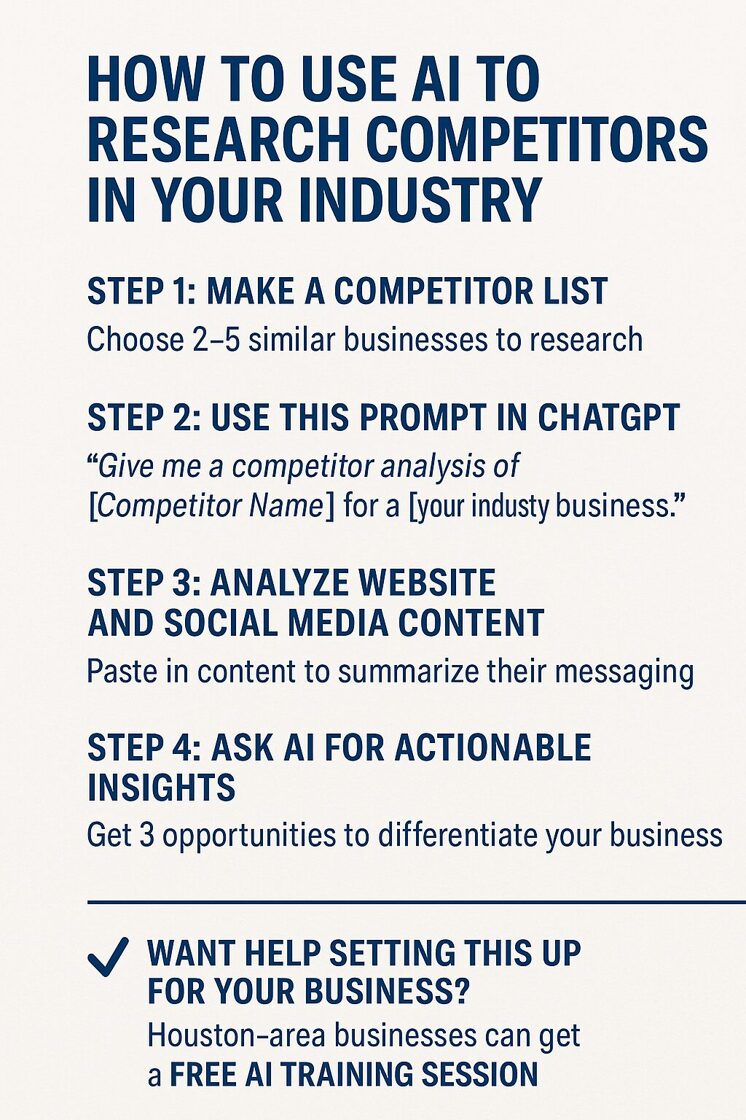
Ever feel like your competitors are one step ahead, but you’re too busy running your business to keep track of what they’re doing?
AI can help you gather insights about your competitors—fast. With the right tools and prompts, you can uncover what’s working for them, what keywords they rank for, what customers are saying about them, and how you can stand out.
And you don’t need to be a tech expert to do it.
Step-by-Step: Use ChatGPT for Competitor Research
Step 1: Make a Competitor List
Start with 2–5 businesses in your area or industry that offer similar services. You can include direct local competitors or major players online.
Step 2: Use This Prompt in ChatGPT
“Give me a competitor analysis of [Competitor Name] for a [your industry] business. Include their target audience, key messaging, online presence, customer reviews, and marketing strategies.”
Do this for each competitor and compare results.
Step 3: Analyze Website and Social Media Content
You can also paste in content from a competitor’s website or social media and ask:
“Summarize the key messages and tone of this business based on this content.”
“What audience is this content targeting?”
Step 4: Ask AI for Actionable Insights
Try this follow-up:
“Based on this competitor analysis, what are 3 opportunities for [Your Business Name] to differentiate itself?”
Bonus Tip: Combine with Free Tools
Pair ChatGPT with tools like:
Google Reviews (for public feedback)
SimilarWeb (traffic and keyword data)
Meta Ad Library (see what ads your competitors are running)
You can paste insights from these into ChatGPT and ask for analysis.
Why This Works
Saves hours of research
Helps clarify your competitive edge
Reveals marketing strategies you can learn from (or improve on)
✅ Want Help Setting This Up for Your Business?
If you’re a Houston-area business, I’m offering a free AI training session to walk you through this process.
We’ll research your competitors together and turn those insights into a plan that works for you.
📅 Call (832) 975-1825 to Book your free session today!
The Future of Work: Co-Bots, Not Replacements - 10 of 10
Part 10 of 10 in Our Intermediate AI Series
DSTech Solutions | Making AI Practical for Small Business
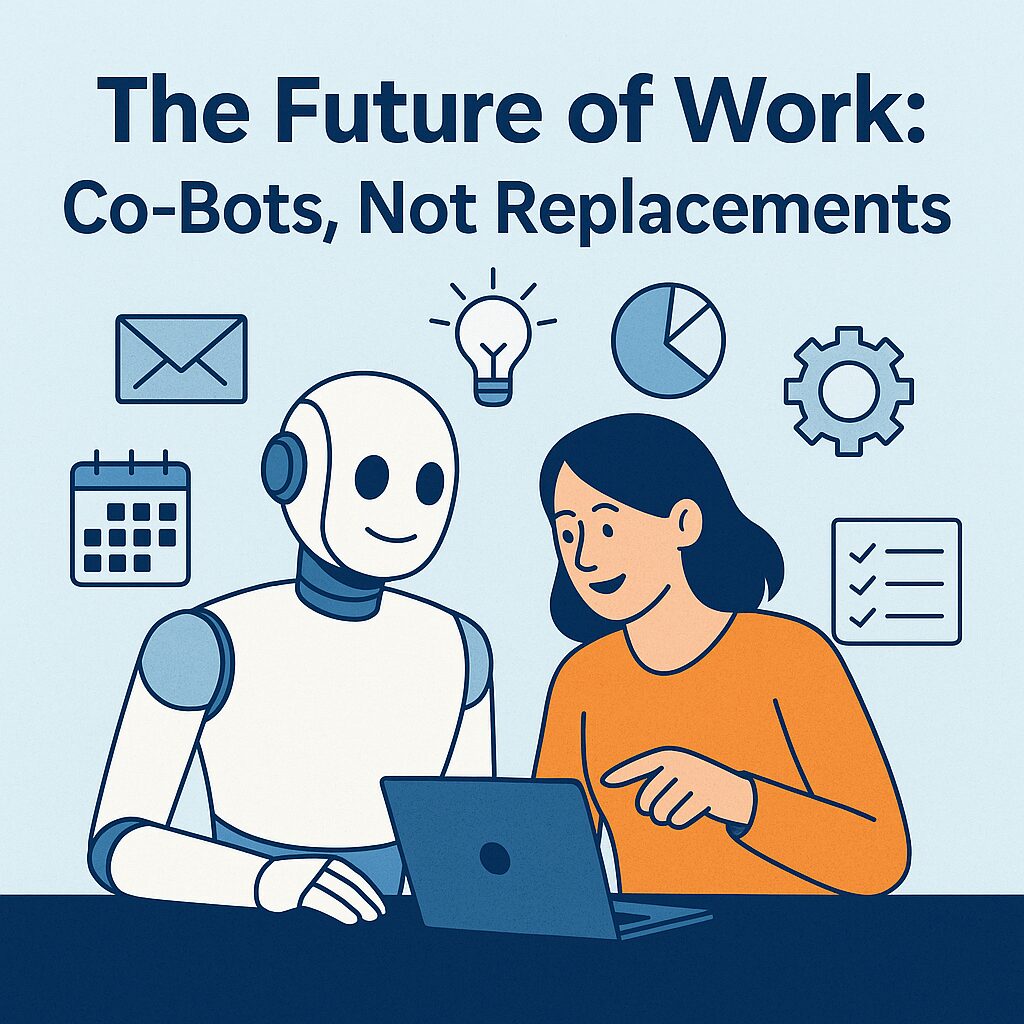
Introduction:
AI isn’t here to take your job — it’s here to reshape how we work. The next generation of tools are designed to augment human intelligence, not replace it. These “co-bots” (collaborative robots) are your tireless digital teammates, freeing you up to focus on higher-value work.
🧠 What Are Co-Bots?
Co-bots are AI systems or robotic tools designed to collaborate with humans. Unlike traditional automation, which removes the human element, co-bots enhance what people can do — like an assistant who never sleeps.
Examples include:
ChatGPT for drafting, brainstorming, and summarizing
AI scheduling assistants that negotiate meeting times
Customer service bots that handle routine inquiries
AI dev tools that suggest code as you type
🧩 Where Co-Bots Fit in the Workplace
| Function | Human Role | Co-Bot Role |
|---|---|---|
| Email Management | Make final decisions | Drafts, sorts, prioritizes |
| Project Planning | Strategic oversight | Tracks timelines, assigns tasks |
| Customer Service | Escalates sensitive issues | Answers FAQs, routes tickets |
| Finance | Oversight and approvals | Reconciliation, invoice matching |
| Sales | Closing and relationship building | Lead scoring, follow-up reminders |
💡 Why This Matters
Productivity doesn't mean burnout. Co-bots free up your time so you can do what humans do best: solve problems creatively, build relationships, and lead.
Job security shifts to job evolution. Your job isn’t disappearing — it’s transforming.
The winners in this new era are the ones who learn how to collaborate with AI, not compete with it.
🔄 Action Step: Train Your Team
Make AI onboarding part of your standard employee development:
Show staff how to use tools like ChatGPT
Provide use-case templates
Encourage experimentation with AI tools
🚀 Final Thought
AI isn’t a threat — it’s a toolset. And the future of work isn’t man vs. machine. It’s man + machine.
Please take a moment to Comment. Your questions are greatly appreciated!
- thanks, Sam
Transforming business operations with smarter technology.
AI Legal and Ethical Risks - 9 of 10
DSTech Solutions | Making AI Practical for Small Business
⚠️ AI Is Powerful—But Not Without Limits
AI is changing how small businesses operate—but some uses still carry serious legal, ethical, or reputational risks. If you're experimenting with AI tools, here’s where to pause and think twice:
❌ 1. Making Legal, Financial, or Medical Decisions
AI can summarize information, but it should not replace licensed professionals when it comes to:
Medical diagnoses or treatment recommendations
Financial investment advice
Legal counsel or contract decisions
Why? AI doesn’t know context or your local regulations. Relying on it here can be dangerous—or even illegal.
❌ 2. Using AI to Generate Content Without Disclosure
Whether it’s blog posts, job descriptions, or client emails—transparency matters. If AI played a role, let readers or clients know.
Google and social platforms are cracking down on undisclosed AI-generated content.
Clients may lose trust if they find out you’re automating without telling them.
❌ 3. Training AI on Sensitive or Proprietary Data
Don’t copy/paste proprietary client info, HR files, or legal documents into public AI tools.
You could violate HIPAA, client NDAs, or company policies.
Even if data is anonymized, many terms of service let companies store and use that info to train their models.
Instead, look into private AI solutions or enterprise licenses that guarantee data protection.
✅ Bottom Line:
AI can amplify your business, but it’s not a free pass. Stay ethical. Stay legal. Stay smart.
Please take a moment to Comment. Your questions are greatly appreciated!
- thanks, Sam
Transforming business operations with smarter technology.
Automating Tasks with AI - 8 of 10
DSTech Solutions | Making AI Practical for Small Business
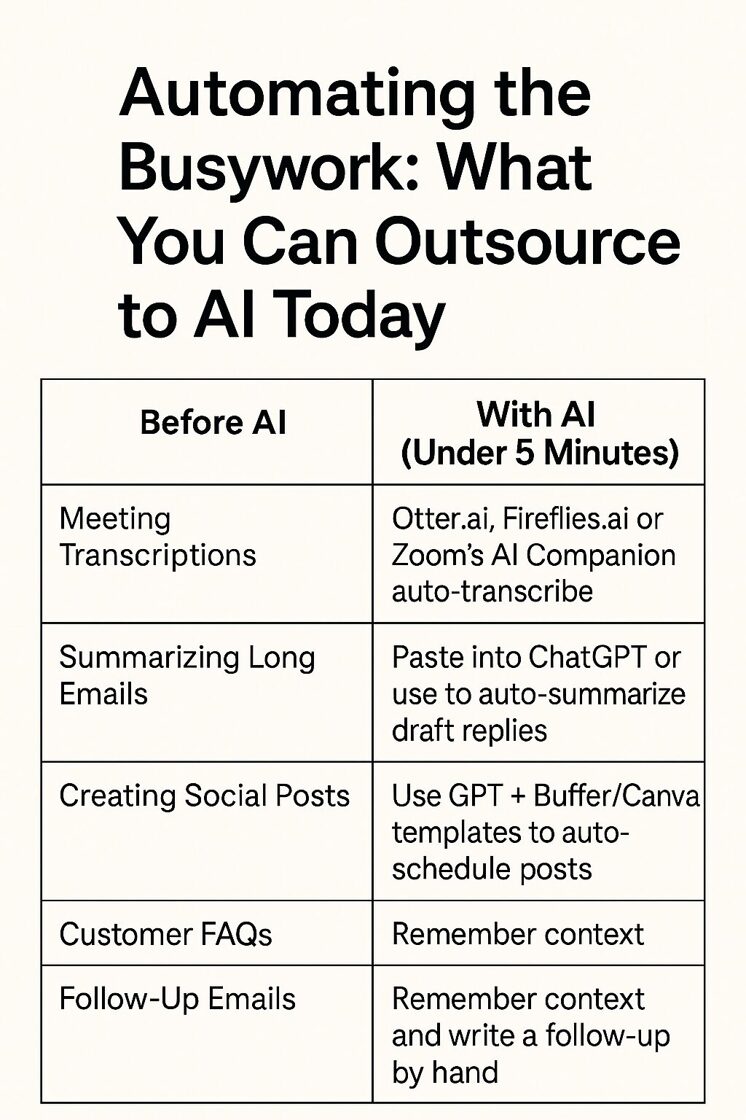
We all have them—those nagging, repetitive tasks that slow us down and steal our focus from more strategic work. The good news? Many of these tasks can now be handled by AI in under five minutes.
Below is a side-by-side comparison of common busywork and how AI can handle them fast:
| Task | Before AI | With AI (Under 5 Minutes) |
|---|---|---|
| Meeting Transcriptions | Manually taking notes or paying for a human transcription service. | Use tools like Otter.ai, Fireflies.ai, or Zoom’s AI Companion to auto-transcribe in real time. |
| Summarizing Long Emails | Reading and distilling key points manually. | Paste into ChatGPT or use tools like Superhuman AI to auto-summarize and draft responses. |
| Creating Social Posts | Write, rewrite, format, and schedule manually. | Use ChatGPT + Buffer/Canva templates to generate and queue posts in minutes. |
| Scheduling Reminders | Set up in calendar manually or use sticky notes. | Use voice-to-AI assistants (e.g., Siri + Reclaim.ai) to create and align reminders instantly. |
| Customer FAQs | Rewriting answers or searching templates each time. | Use AI chatbots like Tidio or Intercom Fin to automate and personalize replies. |
| Data Entry | Manual copy-paste from emails/forms to spreadsheets. | Use Zapier, Make.com, or GPT-automations to extract and populate automatically. |
| Follow-up Emails | Remembering context and manually writing a follow-up. | Use GPT to recall conversation history and write a warm follow-up in seconds. |
| Document Formatting | Reworking fonts, spacing, headers, and layout by hand. | Use Microsoft Copilot or Grammarly’s AI to reformat and polish in one click. |
Final Thought:
If you're spending more than a few minutes on any of the above tasks, AI is ready to take that off your plate. Small automations like these don’t just save time—they eliminate decision fatigue and give you your momentum back.
Please take a moment to Comment. Your questions are greatly appreciated!
- thanks, Sam
Transforming business operations with smarter technology.
Using AI for Your Meetings - 7 of 10
Part 7 of 10 in Our Intermediate AI Series
DSTech Solutions | Making AI Practical for Small Business
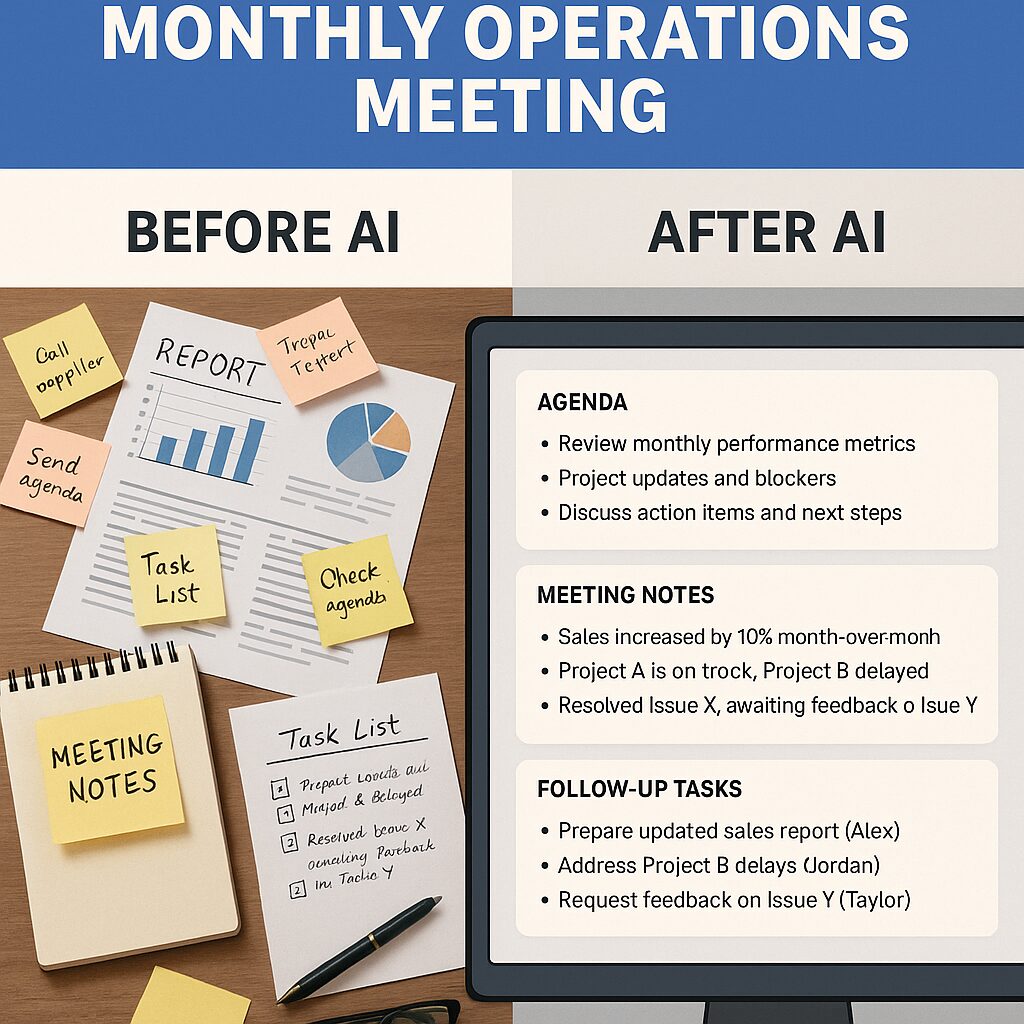
Contact us: https://bit.ly/DSTechContact
Please take a moment to Comment. Your questions are greatly appreciated!
- thanks, Sam
Transforming business operations with smarter technology.
Why Most AI Experiments Fail and How to Fix That - 6 of 10
DSTech Solutions | Making AI Practical for Small Business
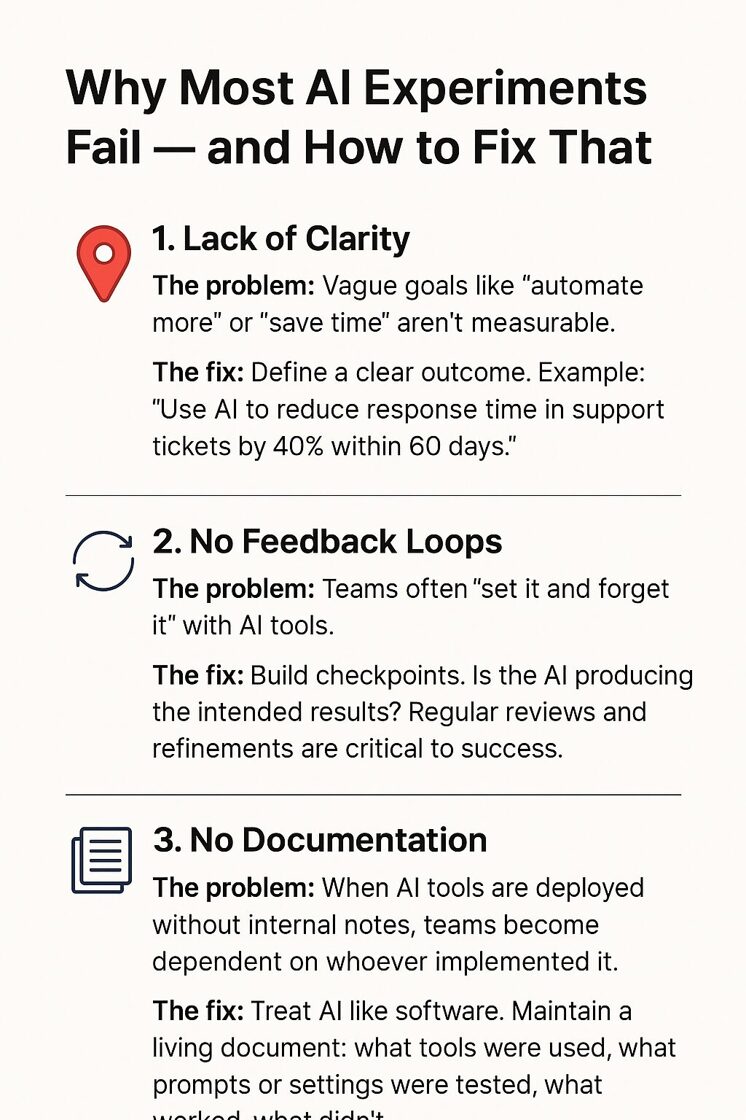
AI holds incredible promise—but too many businesses launch AI projects only to abandon them weeks later. Why? Here are three of the most common pitfalls—and how to turn them around:
🔻 1. Lack of Clarity
The problem: Vague goals like “automate more” or “save time” aren’t measurable.
The fix: Define a clear outcome. Example: “Use AI to reduce response time in support tickets by 40% within 60 days.”
🔁 2. No Feedback Loops
The problem: Teams often “set it and forget it” with AI tools.
The fix: Build checkpoints. Is the AI producing the intended results? Regular reviews and refinements are critical to success.
📚 3. No Documentation
The problem: When AI tools are deployed without internal notes, teams become dependent on whoever implemented it.
The fix: Treat AI like software. Maintain a living document: what tools were used, what prompts or settings were tested, what worked, what didn’t.
💡 Bottom Line:
AI experiments fail when they’re treated like “magic.” Success comes when they’re managed like any other process: with goals, measurement, and iteration.
🔄 Turn It Around:
Start small.
Measure everything.
Capture lessons learned.
Treat AI like a team member: train it, review it, improve it.
Contact us: https://bit.ly/DSTechContact
Please take a moment to Comment. Your questions are greatly appreciated!
- thanks, Sam
Transforming business operations with smarter technology.
Is AI Really Saving You Money? Let’s Talk ROI - 5 of 10
Part 5 of 10 in Our Intermediate AI Series
DSTech Solutions | Making AI Practical for Small Business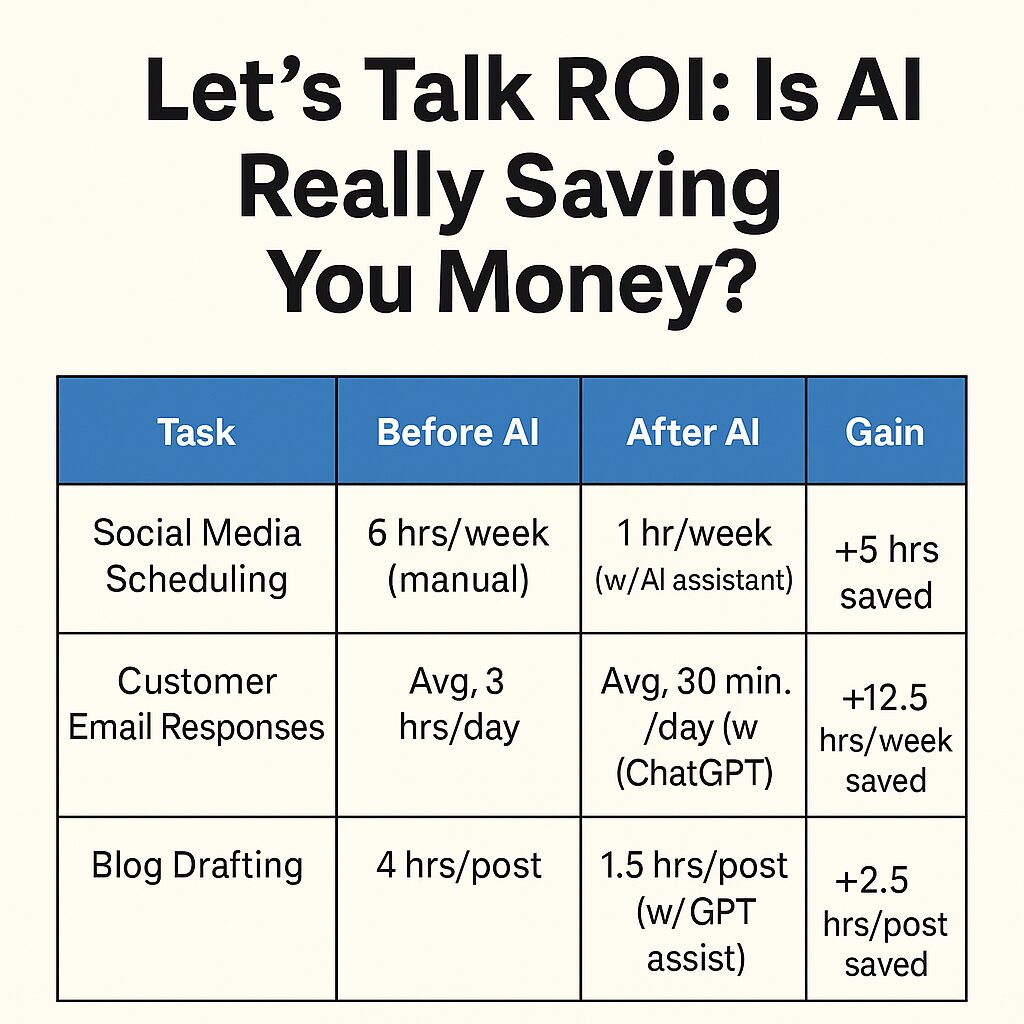
You've automated a few tasks, maybe even built a ChatGPT workflow or integrated Zapier. But here’s the real question: Is it worth it? It’s time to talk about Return on Investment (ROI)—not just feelings, but measurable outcomes.
📊 The Metrics That Matter
To know if AI is actually saving your business money, look at:
✅ Time Saved
How many hours per week have you or your staff recovered? Multiply that by hourly wages to get a dollar figure.
✅ Output Increased
Have you been able to produce more blog posts, reply to more customer inquiries, or shorten your sales cycle?
✅ Error Reduction
Fewer errors = less rework. This saves both time and money.
✅ Headcount Reallocation
Did AI allow you to delay hiring, or reassign someone from grunt work to more valuable tasks?
✅ Revenue Boost
Are you closing more deals, faster? That's direct ROI.
🔁 Before/After Example
| Task | Before AI | After AI | Gain |
|---|---|---|---|
| Social Media Scheduling | 6 hrs/week (manual) | 1 hr/week (w/ AI assistant) | +5 hrs saved |
| Customer Email Responses | Avg. 3 hrs/day | Avg. 30 min/day (w/ ChatGPT) | +12.5 hrs/week saved |
| Blog Drafting | 4 hrs/post | 1.5 hrs/post (w/ GPT assist) | +2.5 hrs/post saved |
💡 Pro Tip:
Use a simple formula to estimate ROI:
ROI = (Gains – Costs) / Costs
If your AI tools cost $300/month and you save 25 hours of labor valued at $50/hour, then:
ROI = ($1,250 – $300) / $300 = 316% ROI
Conclusion:
AI can deliver measurable ROI—but only if you’re tracking it. Start now. Track time, output, errors, and money. You’ll finally know: is AI working for you, or just sounding impressive?
Contact us: https://bit.ly/DSTechContact
Please take a moment to Comment. Your questions are greatly appreciated!
- thanks, Sam
Transforming business operations with smarter technology.
The AI Stack Every Small Business Should Know - 4 of 10
DSTech Solutions | Making AI Practical for Small Business
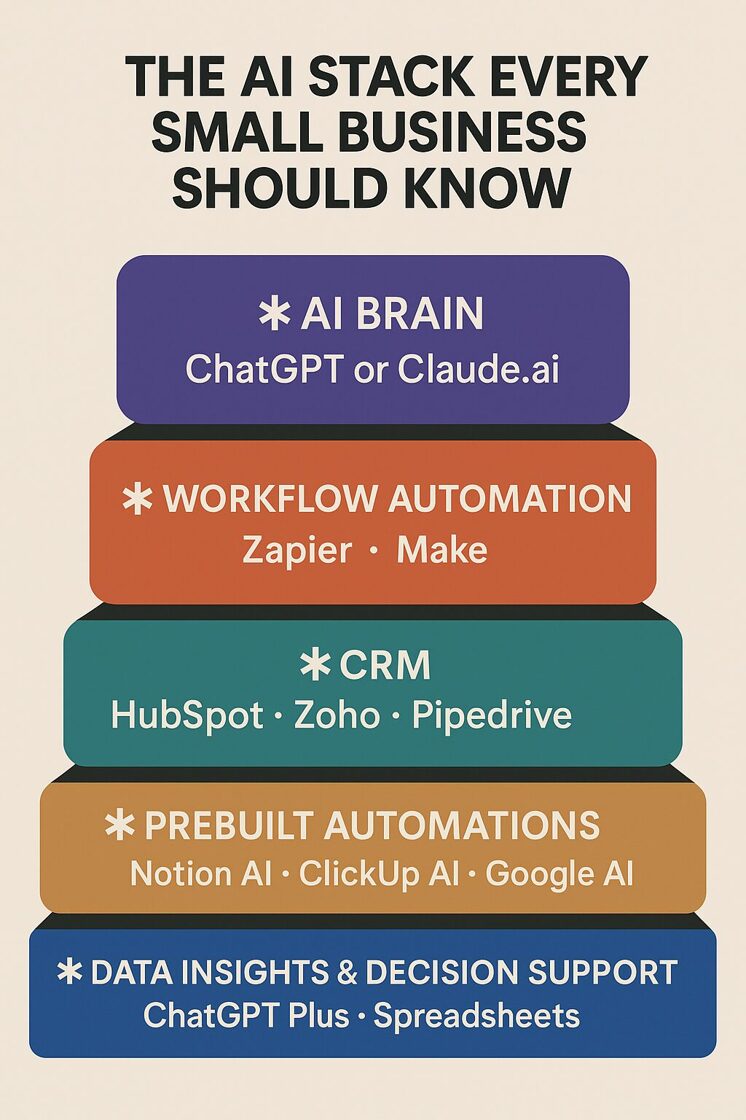
A Practical Look at Tools That Work Together to Save Time, Money, and Sanity
When small businesses think of AI, they often imagine one flashy tool. But the real power comes from the stack—a layered set of tools working together to automate, streamline, and empower.
Here’s a breakdown of the AI Stack every small business owner should know:
🧠 Layer 1: AI Brain — ChatGPT or Claude.ai
This is your thinking layer. These tools help with:
Writing content (emails, posts, letters)
Research and brainstorming
Customer service responses
Document summarization and analysis
Use tools like ChatGPT or Claude.ai to do 80% of your thinking and writing prep. Then polish it with your own human touch.
🔁 Layer 2: Workflow Automation — Zapier or Make
These are your connectors. They link your tools together so they work automatically.
Example uses:
When a lead fills out a form → automatically add them to your CRM + send a welcome email
When a calendar event is booked → notify your team via Slack
Zapier and Make (formerly Integromat) are no-code tools that connect hundreds of apps without hiring a developer.
📇 Layer 3: CRM — HubSpot, Zoho, or Pipedrive
Your CRM (Customer Relationship Management) is your command center for sales and communication.
How AI helps here:
Smart lead scoring
Automatic follow-ups
Personalized email flows
Many CRMs now include AI for predicting deal close rates and optimizing outreach.
🔄 Layer 4: Prebuilt Automations — Notion AI, ClickUp AI, Google AI
This layer lives inside your current tools and quietly boosts productivity.
Examples:
AI auto-generating task lists from meeting notes (ClickUp AI)
Smart document creation in Notion AI
Predictive analytics in Google Workspace
You’re probably already using this layer without realizing it. Time to explore it further.
📈 Layer 5: Data Insights & Decision Support — ChatGPT Plus + Spreadsheets
Combine ChatGPT with your spreadsheets for instant analysis.
Try this:
Paste your sales data into ChatGPT and ask, “What stands out?”
Get a plain-English summary of trends, anomalies, and opportunities
Bonus: Add Google Looker Studio or Power BI for dashboards.
Final Thoughts:
The stack is more than just tools—it’s a system.
Once these layers are connected, you’ll be running a smarter, leaner, more responsive business. And the best part? Most of these tools offer free versions to get started.
Contact us: https://bit.ly/DSTechContact
Please take a moment to Comment. Your questions are greatly appreciated!
- thanks, Sam
Transforming business operations with smarter technology.
What’s Next? Your AI Growth Plan - 3 of 10
DSTech Solutions | Making AI Practical for Small Business
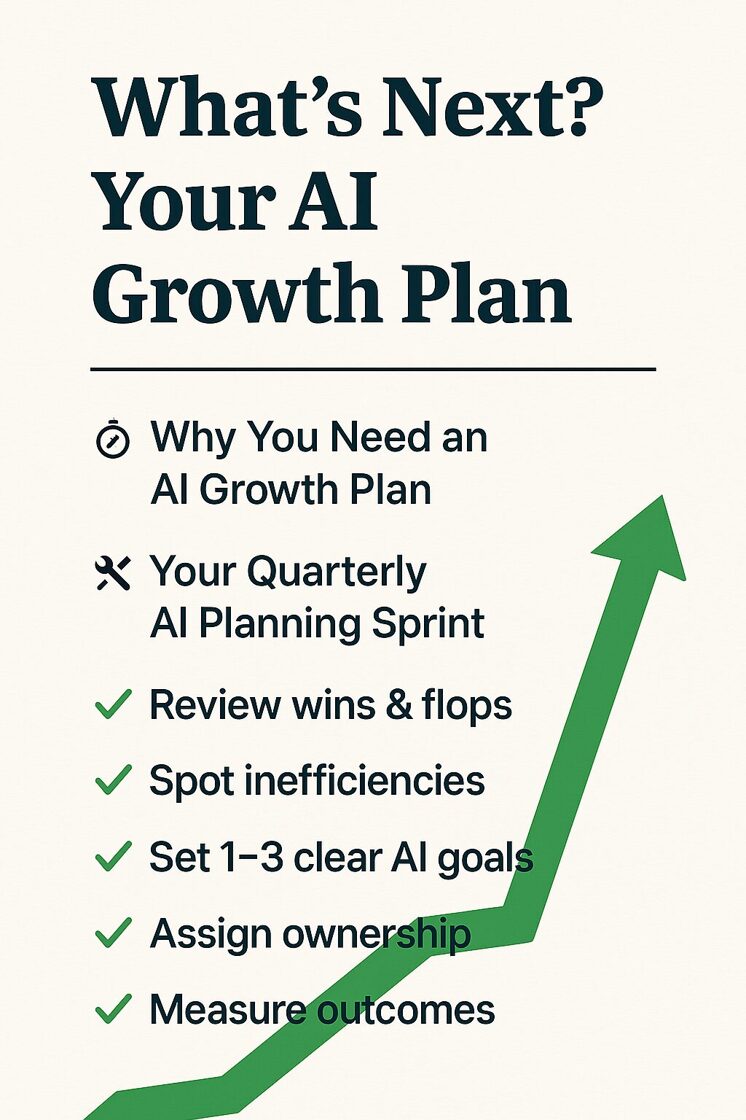
So, you’ve dabbled in AI—automating some emails, cleaning up your documentation, maybe even letting it summarize meeting notes. That’s fantastic.
But now what?
If your team is like most, you’re standing at the edge of a major opportunity: evolving from one-off AI experiments to a strategic, repeatable plan for AI integration.
🧭 Why You Need an AI Growth Plan
AI isn’t a one-and-done tool. It’s a competitive advantage that compounds over time—if you treat it like a business asset. That means creating a roadmap. Not just trying random tools, but stepping back every quarter and asking:
Where did AI save us the most time this quarter?
What processes still feel manual or clunky?
What could we automate or enhance in the next 90 days?
How are we measuring the impact of our AI usage?
Without this kind of review, teams fall into one of two traps: underutilizing AI, or wasting time on tools that don’t serve real goals.
🛠️ Your Quarterly AI Planning Sprint
Once per quarter, set aside a 90-minute session for your team to focus solely on AI growth. Here’s a basic structure:
Review wins & flops
What worked? What didn’t? Where did AI truly help?Spot inefficiencies
What still takes too long? What’s repetitive or error-prone?Set 1–3 clear AI goals
These should be specific. For example:“Automate patient intake summaries in our EHR by July 15.”
“Use AI to triage customer support tickets by next quarter.”Assign ownership
Who’s testing tools? Who’s tracking outcomes?Measure outcomes
Track hours saved, errors reduced, or revenue gained. Quantify the benefit.
📈 Make AI Growth a Habit, Not a Hope
The organizations seeing real results from AI aren’t just lucky. They’re intentional.
They experiment regularly.
They assess impact quarterly.
They learn what works and build it into operations.
With a simple 90-day cadence, your business can move beyond dabbling and start building AI into the DNA of how you operate.
Contact us: https://bit.ly/DSTechContact
Please take a moment to Comment. Your questions are greatly appreciated!
- thanks, Sam
Transforming business operations with smarter technology.
You are Using AI - Now What? - 2 of 10
Part 2 of 10 in Our Intermediate AI Series
DSTech Solutions | Making AI Practical for Small Business
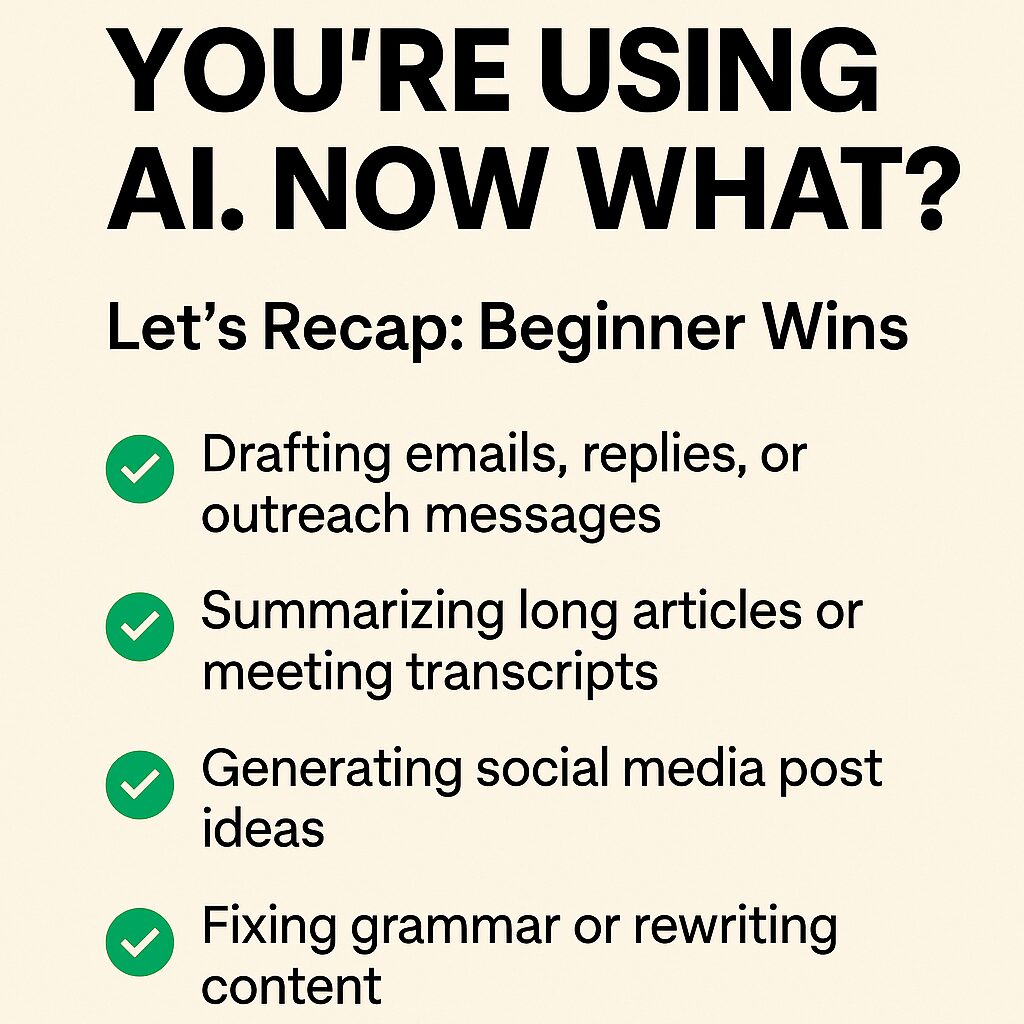
AI isn’t a mystery anymore—you’ve used ChatGPT to draft emails, brainstorm content, maybe even summarize meeting notes. That’s a great start. But now you’re at a crossroads:
➡️ Keep tinkering?
➡️ Or build something transformative?
This post helps bridge the gap between dabbling and doing, setting the stage for intentional, strategic AI adoption.
✅ Let’s Recap: Beginner Wins
You’ve probably used AI for some or all of these:
✅ Drafting emails, replies, or outreach messages
✅ Summarizing long articles or meeting transcripts
✅ Generating social media post ideas
✅ Fixing grammar or rewriting content
✅ Using prompts like “Write this in a more professional tone”
These are productivity boosters—and they matter. Every hour you save compounds.
But here's the thing: AI can do a lot more if you give it structure.
🔁 The Shift: From Tasks to Systems
You’re ready for the next level when:
You use AI more than 3x/week
You keep saying “I bet ChatGPT could help with this”
You start repeating prompts or copying outputs into templates
That means it’s time to evolve from “using AI” to “integrating AI.”
Let’s explore what that means in upcoming posts.
💡 Teaser: What’s Next?
In the next few posts, we’ll cover:
Building AI workflows that save hours per week
Delegating parts of your job (the smart way)
Using AI to drive revenue, not just save time
If beginner AI use is like hiring a great assistant, intermediate use is like building an entire digital department.
Contact us: https://bit.ly/DSTechContact
Please take a moment to Comment. Your questions are greatly appreciated!
- thanks, Sam
Transforming business operations with smarter technology.
AI in the Back Office: Invisible Help That Saves Hours - 1 of 10
DSTech Solutions | Making AI Practical for Small Business
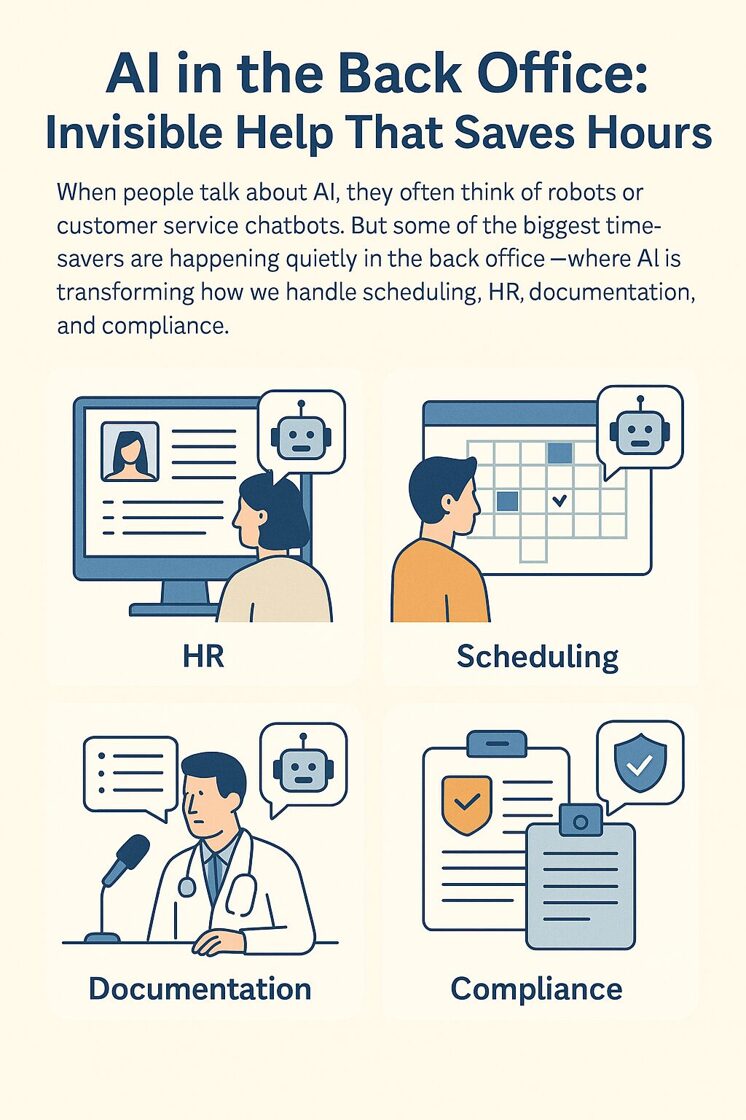
Introduction
When people talk about AI, they often think of robots or customer service chatbots. But some of the biggest time-savers are happening quietly in the back office — where AI is transforming how we handle scheduling, HR, documentation, and compliance.
This post walks through how AI is being used behind the scenes in small to mid-sized businesses — especially in high-compliance environments like healthcare — and what kind of ROI business owners are seeing from these “invisible” assistants.
1. HR Management: Automating the Paper Trail
AI can now handle time-consuming HR tasks like:
Auto-sorting resumes based on skills and experience
Scheduling interviews around availability (on both sides)
Drafting offer letters and onboarding packets using templates
Monitoring employee engagement using anonymized survey analysis
Example:
Instead of a practice manager spending 6 hours a week on hiring paperwork, an AI tool like Zoho Recruit or Workable can reduce that to 1 hour — with improved consistency.
2. Scheduling: Smarter Than a Calendar
AI scheduling assistants can:
Detect patterns in staff availability and patient demand
Auto-fill common appointment types
Send reminders and rebook no-shows without human input
Tools like Clockwise, Clara, or even AI-powered Google Calendar features are doing this today.
In a clinic setting: That could save 10+ admin hours per week, reduce no-shows, and improve patient flow — with zero added headcount.
3. Documentation: From Dictation to Draft
Doctors and professionals are using voice-to-text AI to:
Transcribe patient visits
Generate SOAP notes
Suggest diagnostic codes (ICD-10)
Tools like DeepScribe and Suki use medical language models for accuracy. This reduces after-hours charting and burnout.
4. Compliance Monitoring: Real-Time Eyes on Risk
AI can:
Scan documentation for HIPAA violations
Flag access logs that look suspicious
Monitor for missed signatures or audit gaps
Instead of waiting for an annual review, you get ongoing alerts — and AI writes up the first draft of reports for you.
💡 Why This Matters
These AI tools aren’t flashy. You don’t see them. But they:
Save hours every week
Reduce human error
Protect against fines
Free up skilled staff to do meaningful work
Final Thought:
The future of AI in business isn’t just about talking to machines — it’s about letting machines take over the boring, repetitive stuff so people can do what only they can do.
Contact us: https://bit.ly/DSTechContact
Please take a moment to Comment. Your questions are greatly appreciated!
- thanks, Sam
Transforming business operations with smarter technology.
Your First 10-Minute AI Breakthrough - 10 of 10
DSTech Solutions | Making AI Practical for Small Business
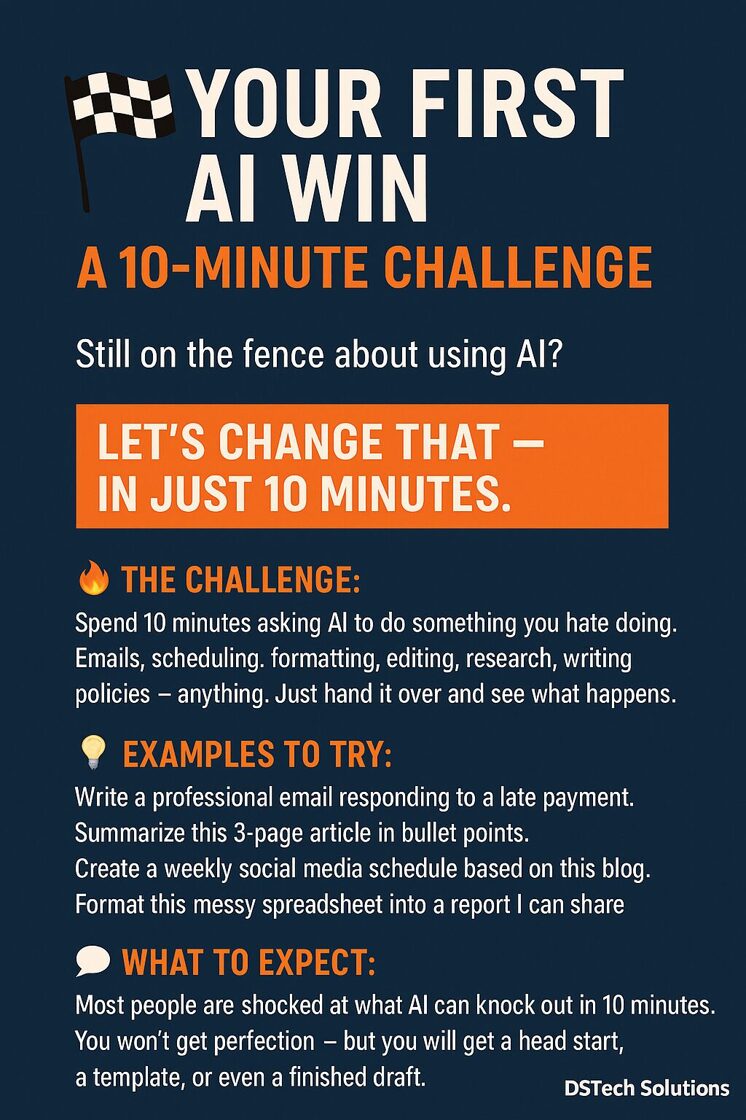
🏁 Your First AI Win — A 10-Minute Challenge That Could Change Everything
Still sitting on the AI sidelines? We get it. New tech can feel intimidating, and you’re already juggling a million things. But here’s the truth: You don’t need to be a tech expert to start benefiting from AI today.
At DSTech Solutions, we help business owners, practice managers, and busy professionals use AI to reclaim hours of their week — and we’ve seen something powerful happen over and over again:
✅ One small AI win turns into massive momentum.
That’s why we’re inviting you to try something bold, fast, and incredibly simple.
🔥 The 10-Minute AI Challenge
We’re not asking for a full-day seminar or a software install.
We’re asking for just 10 minutes.
The challenge:
Ask AI to do something you hate doing — and let it try.
Not sure where to begin? Start here:
💡 Real-World Examples You Can Try Right Now
These are actual things our clients have done in their first 10 minutes:
- "Write this employee review."
- “Write a professional email following up on a late invoice.”
“Summarize this 3-page article into digestible bullet points.”
“Turn this blog post into a weekly LinkedIn content schedule.”
“Clean up this messy spreadsheet and format it for reporting.”
You don’t need fancy training or perfect prompts. Just pick a task and talk to AI like you would a team member.
🛠️ Pro Tip: Treat AI Like a Personal Assistant
The secret to success isn’t precision — it’s momentum.
Try asking:
“Can you turn this onboarding checklist into a PDF for new hires?”
“Rewrite this customer apology to sound more empathetic but professional.”
Once you see how fast AI can produce a solid draft, you’ll never go back.
💬 What to Expect: Fast, Imperfect, but Useful
This isn’t about perfection — it’s about getting unstuck.
In 10 minutes, you can expect:
A starting point where you had none
A rough draft that saves you 80% of the effort
A done-for-you version that’s 90% ready to use
The first time is always the biggest eye-opener.
🎯 Ready for Your First AI Win?
Here’s your simple 3-step plan:
Pick one task you dread.
(Think: emails, formatting, policy writing, scheduling, summarizing)Hand it off to AI.
Use a tool like ChatGPT, Claude, or any AI assistant you trust.Time yourself. Just 10 minutes.
Watch what happens.
You’re not just testing a tool. You’re opening a door.
🚀 Why It Matters
This 10-minute challenge isn’t just about a single win. It’s about starting a new relationship with technology — one that helps you work smarter, not harder.
We believe your time is valuable. Let’s start treating it that way.
Let us know what you tried — and what AI helped you knock off your list.
At DSTech Solutions, we’re here to help you take that first step — and the next.
Contact us: https://bit.ly/DSTechContact
Please take a moment to Comment. Your questions are greatly appreciated!
- thanks, Sam
Transforming business operations with smarter technology.
Is AI Safe to Use in Business? - 9 of 10
Part 9 of 10 in Our Beginner AI Series
DSTech Solutions | Making AI Practical for Small Business
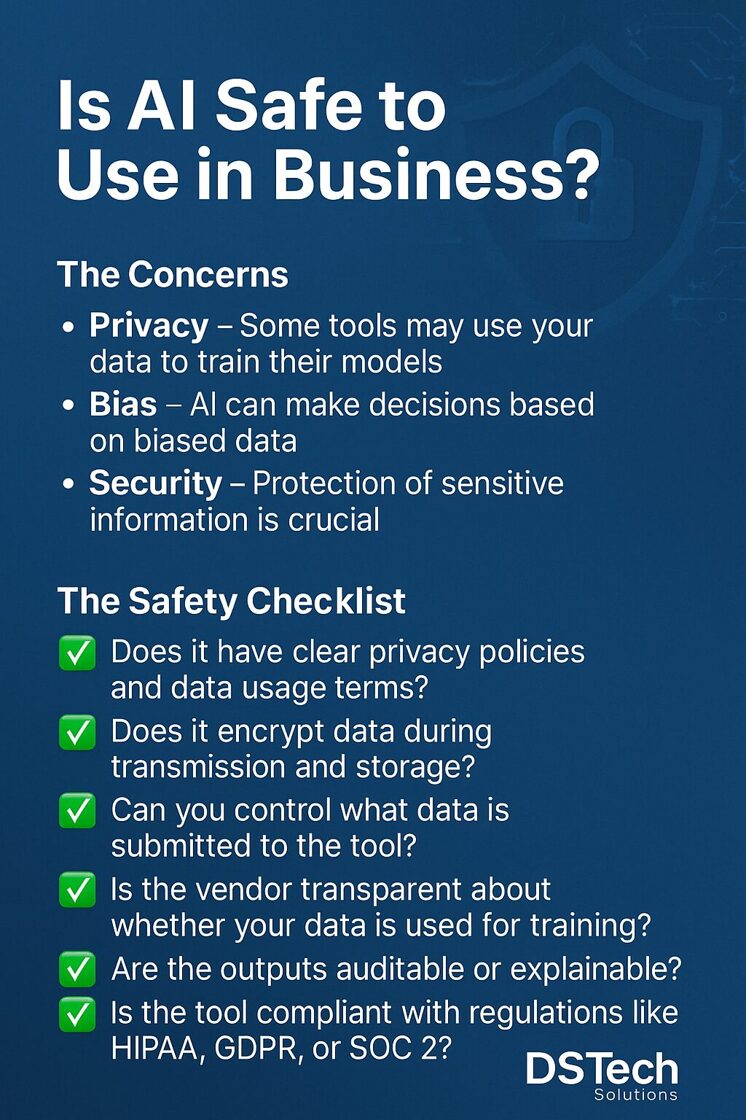
What You Need to Know About Privacy, Bias, and Data Use
At DSTech Solutions, we’re big believers in using AI to save time and streamline your operations—but we also know that responsible use is key. Many business owners are asking: Is AI safe to use in my business?
Here’s the short answer: Yes—if you choose wisely.
⚠️ The Concerns
Privacy – Some tools may use your data to train their models. Always check the tool’s data retention policy.
Bias – AI tools are trained on existing data, which can include biases. This can affect hiring decisions, customer service responses, or content recommendations.
Security – If your data includes sensitive business or customer information, you need tools that offer encryption and compliance with standards like HIPAA or GDPR.
✅ The Safety Checklist
Before using an AI tool in your business, ask:
🔒 Does it have clear privacy policies and data usage terms?
🛡️ Does it encrypt data during transmission and storage?
🤖 Can you control what data is submitted to the tool?
📜 Is the vendor transparent about whether your data is used for training?
👁️🗨️ Are the outputs auditable or explainable?
🌐 Is the tool compliant with regulations like HIPAA, GDPR, or SOC 2?
Final Thought:
AI isn’t just safe—it’s powerful. But like any tool, it should be used with care. If you pick the right tools and understand the risks, you can harness AI to move faster and smarter than ever.
Contact us at: https://bit.ly/DSTechContact
Please take a moment to Comment. Your questions are greatly appreciated!
- thanks, Sam
Transforming business operations with smarter technology.
“Prompting” for Beginners: How to Talk to AI - 8 of 10
DSTech Solutions | Making AI Practical for Small Business
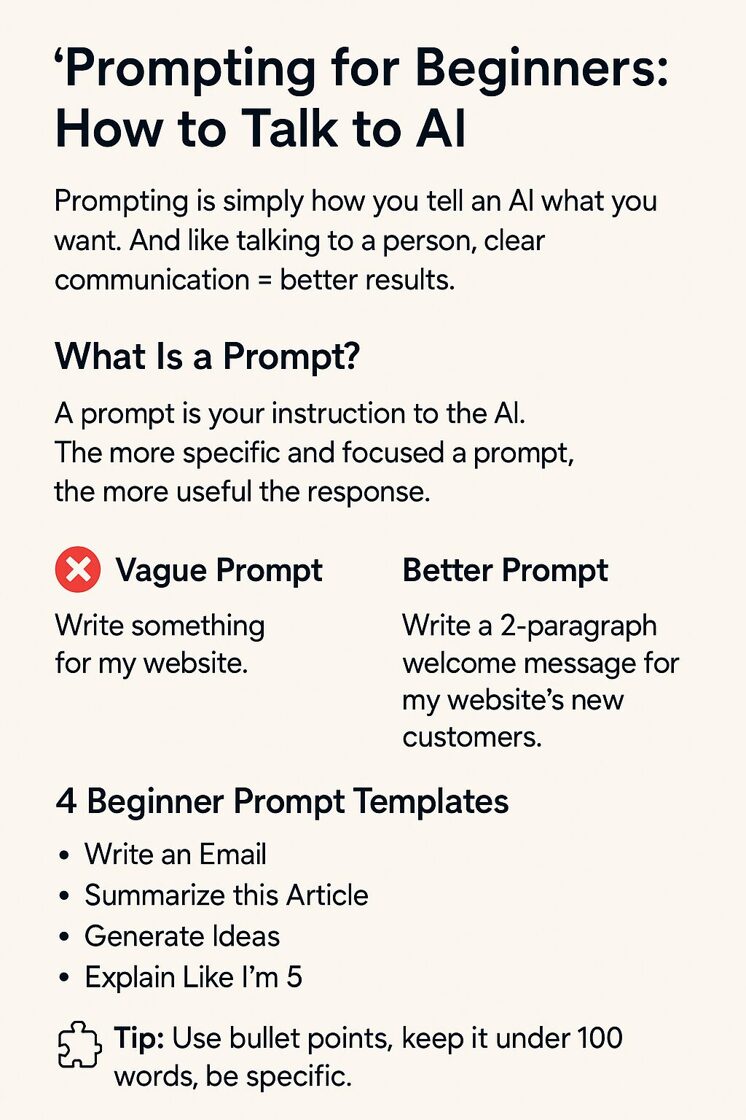
Ever tried using ChatGPT, Claude, or another AI tool and thought, “It didn’t really work for me?”
Chances are, it wasn’t the tool—it was the prompt.
Prompting is simply how you tell an AI what you want. And just like talking to a person, clear communication = better results.
🔹 What Is a Prompt?
A prompt is your instruction to the AI.
The more specific and focused you are, the better the outcome.
🛠️ Good Prompts vs. Vague Prompts
❌ Vague Prompt:
Write something for my website.
✅ Better Prompt:
Write a 2-paragraph welcome message for new customers visiting my website for the first time. Keep it friendly, warm, and use plain English.
💡 4 Beginner Prompt Templates
1. Write an Email
Prompt: Write a short welcome email for a new customer who just signed up for our monthly service. Mention that they can contact us anytime with questions.
2. Summarize Something
Prompt: Summarize this article in 3 bullet points for a LinkedIn post. Keep it under 100 words.
3. Generate Ideas
Prompt: Give me 5 blog post ideas for a small business that sells handmade furniture online.
4. Explain Like I’m 5 years old.
Prompt: Explain what cryptocurrency is in simple terms a 10-year-old can understand.
🧩 Prompting Tip: Add Structure
Use structure words like:
“In 3 bullet points…”
“Keep it under 100 words…”
“Write it in a casual tone…”
“Use first-person voice…”
🗣️ Your Turn
Try it! Practice one of these prompt types and share your results.
Want help writing better prompts? Just ask!
Contact us at: https://bit.ly/DSTechContact
Please take a moment to Comment. Your questions are greatly appreciated!
- thanks, Sam
Transforming business operations with smarter technology.
Simple AI Tools You Can Try Today - 7 of 10
DSTech Solutions | Making AI Practical for Small Business
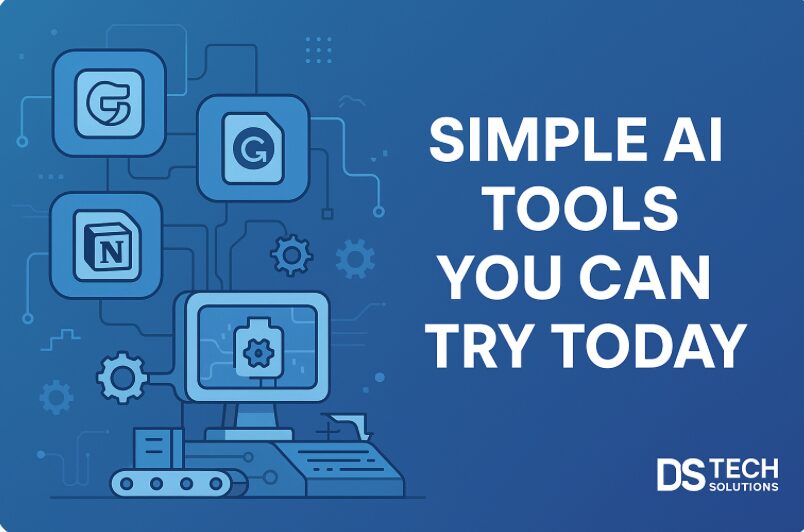
AI may sound intimidating, but the truth is—many tools are incredibly user-friendly and ready to make your work life easier today, not someday. You don’t need to be a programmer or data scientist. Here are a few simple, powerful tools your team can start using right now:
1. ChatGPT (by OpenAI)
Great for:
Drafting emails, blogs, and social posts
Summarizing reports
Brainstorming ideas
Automating repetitive writing tasks
Try it: chat.openai.com
Tip: The free version works well for basic use. Paid versions offer access to the most advanced models.
2. Claude (by Anthropic)
Great for:
Handling longer documents
Clearer explanations with built-in guardrails
Business writing and contracts
Try it: claude.ai
Tip: Claude is especially good at interpreting complex text and policy documents.
3. GrammarlyGO
Great for:
Enhancing grammar and tone
Drafting professional content quickly
Rewriting unclear text
Try it: Available inside Grammarly browser extension
4. Notion AI
Great for:
Project planning and note-taking
Generating task lists, meeting summaries, and wikis
Internal team documentation
Try it: notion.so
Tip: Built right into your workspace if you're already a Notion user.
5. Canva Magic Write
Great for:
Marketing materials and visual content
Caption writing
Campaign ideas
Try it: Inside Canva (canva.com)
Start Small, See Results
You don’t have to roll out a full-blown AI strategy to benefit. Just letting one or two team members explore these tools can lead to time savings and new insights. At DSTech Solutions, we’ve seen small steps lead to big changes for our clients—especially in industries like healthcare, where time and clarity are at a premium.
Ready to explore AI for your business?
Let us help you identify the low-hanging fruit. From training sessions to implementation guidance, DSTech Solutions is here to make AI approachable, safe, and effective.
✉️ Want help getting started?
Contact us at: https://bit.ly/DSTechContact
Please take a moment to Comment. Your questions are greatly appreciated!
- thanks, Sam
Transforming business operations with smarter technology.
AI Isn’t Here to Replace Your Team—It’s Here to Empower Them
DSTech Solutions | Making AI Practical for Small Business
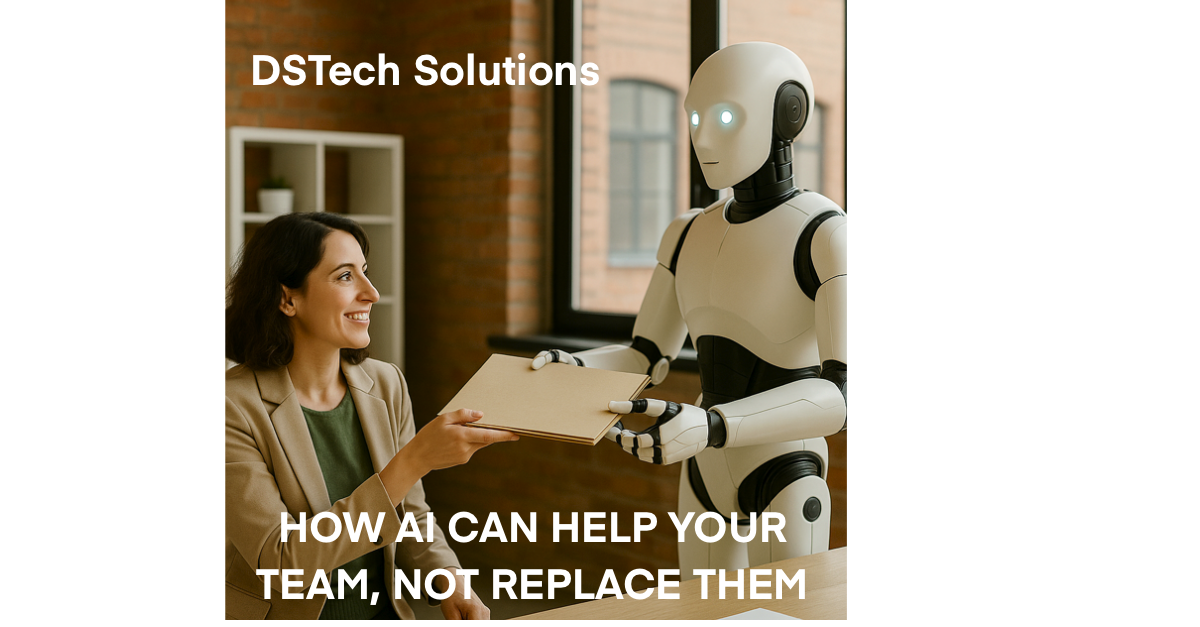
At DSTech Solutions, we’re often asked a critical question by business owners and team leaders:
“Is AI going to replace my employees?”
It’s a fair concern—but the real power of AI doesn’t come from replacing people. It comes from augmenting them. The best AI tools are not here to cut your workforce—they’re here to amplify your team’s impact, reduce burnout, and unlock creativity.
✅ Free Your Team From Low-Value Tasks
Every business has tasks that are necessary but repetitive:
Data entry
Manual report generation
Inbox triage
Scheduling
File organization
AI can automate these tasks, giving your team more time for strategic thinking, personal client interaction, or innovation. The result? Less time spent on drudgery and more time on what moves your business forward.
💡 Enhance Decision-Making With Smarter Tools
AI doesn’t just automate; it helps your team make better decisions. Imagine your staff having access to:
Instant insights from customer data
Trend predictions
Risk flags and opportunity alerts
Now your employees become smarter, faster, and more confident in their decisions—without needing to become data scientists.
🤝 AI Is a Teammate, Not a Threat
Think of AI as an intern who never sleeps, doesn’t need breaks, and follows directions perfectly. It can:
Draft emails and documents for review
Generate first-class reports.
Monitor systems for anomalies
Keep tabs on compliance rules
But it still needs your team’s judgment, strategy, and personal touch to turn outputs into results.
📈 Upskill, Don’t Downsize
Forward-thinking companies are using AI to upskill their teams, not shrink them. When your employees learn to collaborate with AI tools, they gain a competitive advantage—and your business becomes more agile, not more automated.
Bottom Line:
AI doesn’t replace people. It empowers them.
The businesses that succeed with AI aren’t those that remove humans from the equation—they’re the ones that give their people better tools.
If you’re ready to explore how DSTech Solutions can help your team work smarter with AI, let’s talk.
Please take a moment to Comment. Your questions are greatly appreciated!
- thanks, Sam
Transforming business operations with smarter technology.
Common AI Terms Defined: A Beginner’s Glossary
DSTech Solutions | Making AI Practical for Small Business
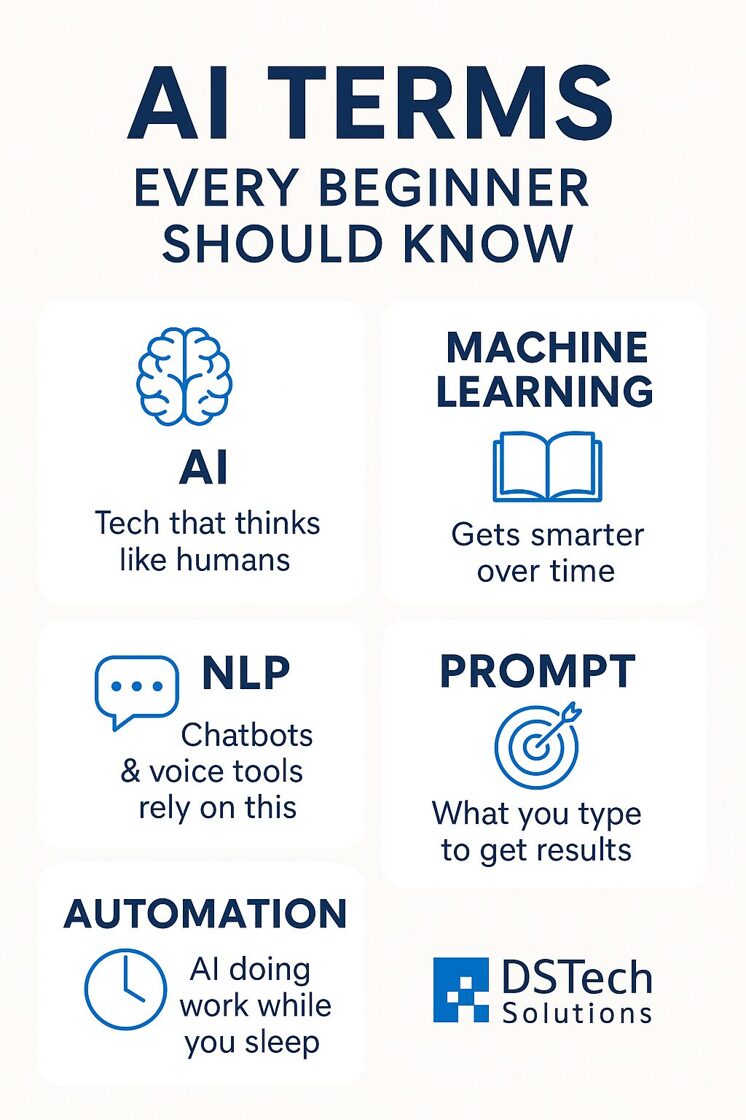
Artificial Intelligence can sound like a foreign language if you’re just getting started. At DSTech Solutions, we believe in making AI practical and approachable—so we’ve compiled this simple glossary of common AI terms. Whether you’re a small business owner, office manager, or practice administrator, this guide will help you feel more confident as you explore AI tools.
🤖 Artificial Intelligence (AI)
Definition: The broad field of creating machines that mimic human intelligence—like learning, reasoning, and problem-solving.
Think of it as: The umbrella that covers everything from chatbots to self-driving cars.
🧠 Machine Learning (ML)
Definition: A subset of AI that enables machines to learn from data and improve over time without being explicitly programmed.
Example: Email filters that learn to recognize spam based on what you mark as junk.
📊 Algorithms
Definition: A set of step-by-step instructions or rules used by AI to make decisions or solve problems.
Real-world analogy: A recipe in a cookbook—but for data.
📚 Training Data
Definition: The information or examples given to an AI so it can learn patterns and make predictions.
Example: Feeding thousands of images of invoices to an AI to help it learn to recognize and extract payment information.
💬 Natural Language Processing (NLP)
Definition: The branch of AI that allows machines to understand and respond to human language.
Used in: Chatbots, voice assistants, AI writing tools.
🧠 Neural Networks
Definition: Computer systems inspired by the human brain that help AI detect complex patterns in data.
You’ve seen it in: Image recognition, facial detection, and advanced fraud alerts.
🎯 Prompt
Definition: A piece of text or instruction given to an AI (like ChatGPT) to produce a response.
Tip: Clear, specific prompts get better results—like giving good directions to a helpful assistant.
📦 Model
Definition: The trained system that produces AI output based on data and algorithms.
Think of it as: The "brain" that’s been trained and is now ready to work.
🧪 Fine-Tuning
Definition: Customizing an AI model with your specific data to make it more accurate or relevant to your needs.
Great for: Tailoring an AI chatbot to understand your business’s tone or procedures.
⏱️ Automation
Definition: Using AI or software to perform repetitive tasks without human input.
Common examples: Auto-scheduling social media, summarizing emails, generating reports.
Final Thoughts
You don’t need to become a data scientist to benefit from AI—but knowing the language makes it easier to navigate this space. At DSTech Solutions, we help small businesses like yours implement real-world AI solutions that save time and improve operations.
If you're ready to explore how AI can work for your team, contact us today—we speak both tech and plain English.
Please take a moment to Comment. Your questions are greatly appreciated!
- thanks, Sam
Transforming business operations with smarter technology.
Creating Reports With AI - Beginner - 4 of 10
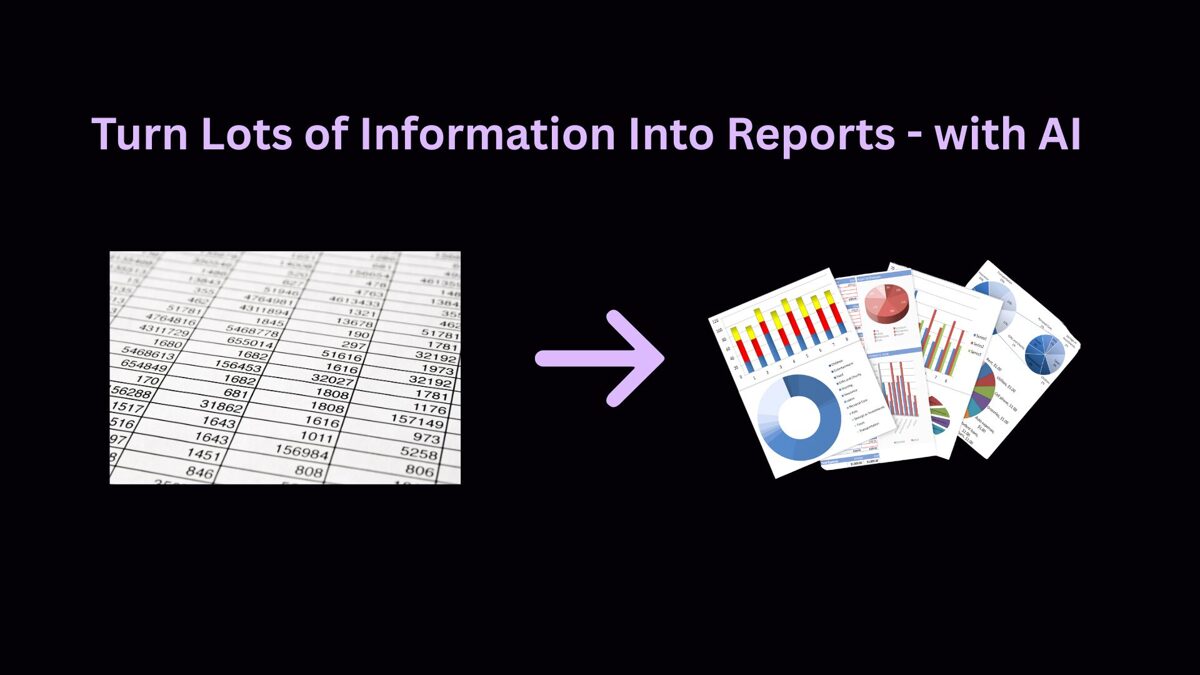
Ever had to read a long report, just to get a few key takeaways?
AI can do that for you in seconds.
At DSTech Solutions, we help professionals use AI to save time and reduce mental fatigue. One of the simplest and most powerful ways to start is by using AI to summarize long documents, reports, or articles.
🛠️ Example:
Upload a PDF, paste in a long email thread, or drop in the text of a compliance report. Tools like ChatGPT will scan the content and give you a clear, concise summary.
✅ What You Get:
- Key points and action items
- Shorter version you can share with your team
- Time back in your day
🎯 Use Cases:
- Compliance reports
- Meeting minutes
- Vendor contracts
- Policy updates
- Training manuals
💡 Tip:
Ask your AI tool:
“Summarize this for me in bullet points and highlight any deadlines or next steps.”
AI won't replace your judgment—but it will cut your reading time in half.
👉 Want to see what it’s like to work with a 100% owner-led team?Let’s talk: www.dstechsolutions.com/contact
Please take a moment to Comment. Your questions are greatly appreciated!
- thanks, Sam
Transforming business operations with smarter technology.

